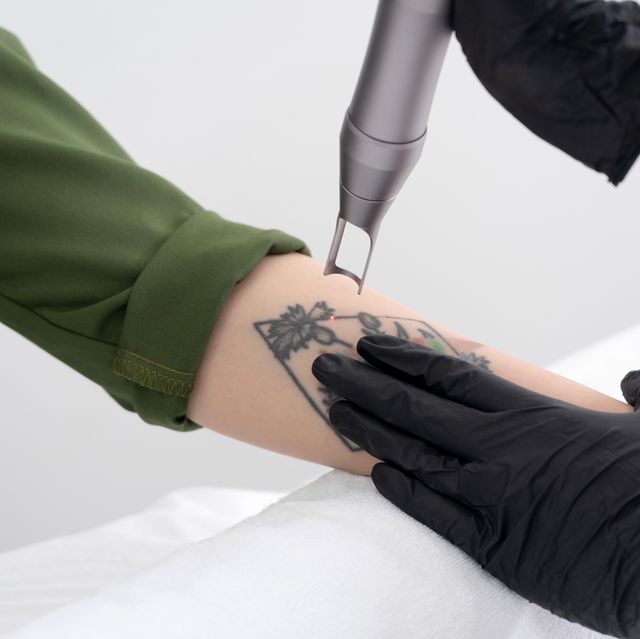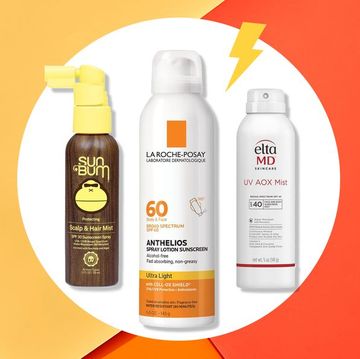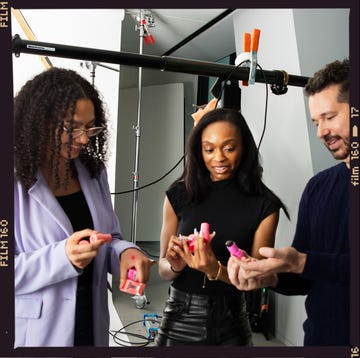Have you ever gotten a tattoo and felt regret slowly creeping up on you as time passed? Have you ever wanted a tattoo but the words "permanent" and "forever" haunt you? If so, you may have already considered tattoo removal.
There are many reasons why someone would want to remove a tattoo. Maybe there was an error in your tattoo design, or perhaps you just can't relate to your ink anymore. There's also the possibility that, since tattoo ink can "bleed" over time, the look of your design may be a lot different than when you first got it.
Meet the experts: Azadeh Shirazi, MD, a board-certified dermatologist specializing in medical, surgical, and cosmetic dermatology, Debra Jaliman, MD, a New York-based board-certified dermatologist with a focus on cosmetic dermatology and general dermatology.
While tattoos technically are permanent, there are a few different methods you can consider to have them removed. Read on for everything there is to know about tattoo removal, including how it works, what it feels like, and how it heals.
How can a tattoo be removed?
The most common tattoo removal method is laser removal, though the process is more complex than a laser that simply zaps away the ink. It actually breaks the ink into tiny fragments before your body takes care of the rest.
"The ink doesn’t come off your skin, but actually gets absorbed into your body," explains Azadeh Shirazi, MD, a board-certified dermatologist specializing in medical, surgical, and cosmetic dermatology. "White blood cells engulf the shattered ink particles away into the lymphatic system with your body eventually excreting it in your urine, feces, or sweat."
There are a few kinds of lasers that are commonly used during tattoo removal, and the type that your removal specialist uses on you may depend on what color your tattoo is. An Nd:YAG laser, for example, may be used if your tattoo contains a lot of blacks, grays, and/or browns, while Ruby and Alexandrite lasers are typically used to remove blue and green pigments.
Note: Black ink is the easiest to remove because it absorbs all possible wavelengths. Also, the older a tattoo is, the faster it can be removed.
If the idea of tattoo ink getting absorbed into your body makes you a little uneasy, Dr. Shirazi recommends a newer method called Tatt2Away that clears the ink by forming a scab on the surface of the skin instead of depending on the lymphatic system to clear it up.
To prepare for your first session, shower beforehand so that your skin is completely clean. The area being treated should also be clear of lotions, oils, creams, and fragrances. Avoid spending excessive hours in the sun or tanning bed treatments, and arrive to your appointment wearing loose clothing.
Does tattoo removal hurt?
While most people might tell you that getting laser tattoo removal hurts just as much (if not more) than actually getting the tattoo, it's important to remember that everyone's pain tolerance is different. According to Debra Jaliman, MD, a New York-based board-certified dermatologist with a focus on cosmetic dermatology and general dermatology, laser tattoo removal "feels like snapping rubber bands against the skin," but you should expect a numbing cream to be applied to the area beforehand.
"It’s a little uncomfortable but hurts less than getting the tattoo," she says. "A topical anesthetic cream is used to numb the skin, [so] most people don’t feel much of anything."
Dr. Shirazi adds that facilities that do laser treatments instead of Tatt2Away might recommend a shot of lidocaine instead.
How long does it take to remove a tattoo?
Getting new ink can take as little as an hour, depending on what you're getting. Unfortunately, removal is a much longer process that can take anywhere from six months to a year.
You'll have four to eight weeks to heal between sessions, and each session can take up to half an hour. If your tattoo has colored ink, you'll need more sessions with laser treatment. Dr. Shirazi notes that this process will look different for someone who uses Tatt2Away.
"Tatt2Away does not depend on ink color, as it removes all ink colors in a given session by drawing it out of the skin as a scab form and dispels the ink from the body," she explains. "It often requires 3-5 sessions regardless of ink color whereas laser tattoo removal often requires 5-15 sessions."
Are there any side effects of tattoo removal?
Like almost any procedure, side effects are a possibility. With laser tattoo removal, you may experience redness or hyperpigmentation. However, both are temporary and can fade within three to six weeks. Tylenol or ibuprofen can also help you manage any pain that follows a session.
To aid the healing process, Dr. Shirazi emphasizes keeping the skin out of the sun and keeping it covered for the first 24 hours. Use a gentle cleanser and Vaseline the next day followed by a bandage if needed. Dr. Jaliman adds that staying out of pools or the ocean is essential to avoid an infection.
"After seven to ten days, I recommend using a silicone gel sheet applied eight to ten hours a day," says Dr. Shirazi. "This can be overnight when you are sleeping or during the day to help with tissue healing and remodeling."

Sabrina is an editorial assistant for Women’s Health. When she’s not writing, you can find her running, training in mixed martial arts, or reading.













